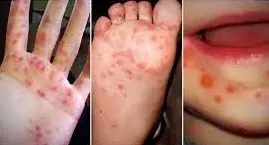Hand, foot and mouth disease (HFMD) is a viral infection that causes a rash or blisters on the hands, feet and around the mouth. It usually affects children under the age of 10 but can also infect older children and even adults. Find out more about this infectious disease in our article below.
PSA: Medical Channel Asia (MCA) is now on Telegram! Join us here for daily reads and the latest updates at your fingertips!
Introduction to Hand Foot Mouth Disease
HFMD is a viral condition that is caused by the virus that belongs to the Enterovirus family. This condition is usually confused with foot-and-mouth disease, which affects cows, sheep, and pigs, though there is absolutely no relationship between the two, other than the similarity in name.
Prevalence of Hand Foot Mouth Disease
HFMD outbreaks usually happen in childcare centres during the warm periods of the year. It is found to be seasonal in temperate Asia with a summer peak and in subtropical Asia with spring and fall peaks, but not in tropical Asia. A study carried out in China in 2018 found that around 2400 children per 100,000 have HFMD under the age of 5. Not many epidemiology studies are available in the medical community.

Figure 1. Children with HFMD
Transmission and Prevention of Hand Foot Mouth Disease
HFMD is usually spread by direct contact with fluid from skin blisters, nose and throat discharges. Saliva, sputum, phlegm, nasal mucus, sneezing, droplets, faeces are all common media for the virus to transmit.
Prevention is the key to reducing the likelihood of having HFMD in children. Some key things to consider include:
- Good hand hygiene: use alcohol-based soap to thoroughly clean children’s hands regularly, especially before eating and after contact with faeces or discharges.
- Do not share eating and drinking utensils.
- Do not share personal hygiene items like towels, toothbrushes.
- Teach children about cough and sneeze etiquette.
For staff in childcare centres or primary schools, children with confirmed HFDM should be put into quarantine until the skin blisters have dried.
High-Risk Population
- The viruses that cause HFMD particularly target children.
- Children with an infected household member
- Many adults, including pregnant women, are often exposed to the virus without showing any symptoms due to a strong immunity suppression. However, they can still transmit the virus to their newborn babies.
- Childcare centres are particularly prone to outbreaks.
Symptoms of Hand Foot Mouth Disease
There are three main symptoms parents should be aware of:
- Flu-like symptoms: Fever is a common sign of infection. Increased body temperature will make children eat less, look unwell, feel tired and have a sore throat.
- Mouth sores: Ulcers and blisters could develop both around and inside the mouth. They are usually painful and cause extra drooling.
- Skin rash and blisters: Rash could develop on the palms and soles. The rashes are usually flat, red in colour, and sometimes come with blisters. The fluid from the blisters contains the virus and parents should handle the fluid with caution. Perform hand hygiene before and after touching your children’s rash. Usually, the blisters do not grow in the mouth, so patients can drink and eat as usual.
Symptoms usually start 3 to 7 days after becoming infected, and last from 7 to 10 days. Not everyone presents with the same set of symptoms, depending on the specific variant of virus you are infected with.
Diagnosis of Hand Foot Mouth Disease
Diagnosis is usually based on patients’ age, symptoms and the appearance of the rash. Doctors may also collect samples from the blisters or faeces for lab analysis. Also, doctors may test for the presence of the virus by sending the patient for a throat swab.
Treatment of Hand Foot Mouth Disease
Luckily, HFMD usually does not cause severe illness and is considered self-limiting. Most children could recover on their own after 7 to 10 days. Common medications like paracetamol and ibuprofen could be taken to relieve the fever and sore throat. In the meantime, parents should make sure their kids are having enough fluids. Children between 4 to 13 years old should have 1.5 to 2L of water each day. Leave the blisters to dry naturally and do not attempt to squeeze or pierce them. The fluid leaked from the blister can cause further spread of the virus and infection. Always consult a healthcare professional if you suspect your children have HFMD.
Conclusion
Hand, Foot and Mouth Disease (HFMD) is a viral disease that occurs mainly in children. Main symptoms include flu-like symptoms (like pain and fever), mouth ulcers and skin rashes. Although it does not usually cause severe illness, you should seek advice from a healthcare professional if you suspect your child is suffering from HFMD.
Did you find this article useful and informative? Do you have more questions regarding this topic, or any other topics related to medical and healthcare? Send your questions to [email protected] now!
